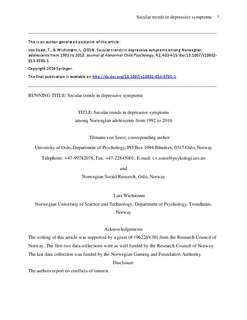| dc.description.abstract | Several survey studies among adolescents have shown increasing rates of depressive symptoms over the last two to three decades. We know however little about mechanisms that might explain this increase. The present study uses data from three nationwide representative surveys of 16-17 year-old Norwegian adolescents that were conducted according to identical procedures in 1992, 2002, and 2010 (response rates 97.0, 91.0, 84.3 %, respectively). At each time point, approximately 3,000 adolescents participated (48.8 % girls and 51.2 % boys). Questionnaire data on depressive symptoms and a variety of potential risk and protective factors that might explain time trends in such symptoms were assessed at all time points. The results showed that the prevalence of high scores on depressive symptoms increased significantly between 1992 and 2002 among both boys and girls. No significant changes were observed between 2002 and 2010. The increase from 1992 to 2002 among girls and boys could be partially attributed to increases in eating problems and cannabis use, while reduced satisfaction with own appearance among girls contributed as well. Although the study does not provide information about the causal direction between putative risk factors and depressive symptoms, the results provide some indication that eating problems, cannabis use, and appearance related factors may contribute in explaining secular trends in depressive symptoms. | |
